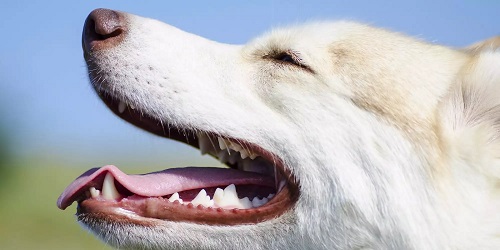How many teeth does a dog have?
How many teeth does a dog have?
As you well know, the teeth of animals are specifically adapted to their type of diet. Dogs, being carnivorous animals, have incisor and canine teeth that allow them to grab, tear and tear meat, as well as premolars and molars that allow them to cut and grind food.

How many teeth do dogs have?
Dogs, like people, are heterodonous animals , which means they have teeth of different shapes and sizes. Specifically, our canine companions have 4 types of teeth:
- incisors
- Canines (or fangs)
- premolars
- molars
The dental formula is a schematic representation that allows us to know how many teeth of each type an animal has. To interpret this simple scheme, we must take into account the following points:
- The teeth are numbered in this order : incisors (I), canines (C), premolars (P) and molars (M).
- The numerator refers to the upper arch (maxilla) and the denominator, to the lower arch (mandibular).
- Both the numerator and the denominator refer only to the middle of the arch (i.e., half maxilla or half mandible, respectively), since they are symmetrical (i.e., there are the same number of teeth on the left side as on the right). law). Therefore, to find out how many teeth dogs have in total, you have to multiply the dental formula by 2.
Knowing this, we can already reveal what the dental formula of dogs is. But first, we need to remember that dogs have two types of teeth (milk and permanent) and that each one has a different dental formula. Therefore, we must separately address how many teeth puppies have and how many teeth adult dogs have.
- The primary dentition of dogs follows the formula: 2x (I 3/3, C 1/1, P 3/3) . That is, puppies have a total of 28 teeth .
- The permanent dentition of dogs follows the formula: 2x (I 3/3, C 1/1, P 4/4, M 2/3) . That is, adult dogs have a total of 42 teeth .
Knowing how to interpret these simple diagrams, we can easily answer questions such as:
- How many teeth does a down dog have? To find out, we simply have to add the denominators and multiply the result by 2. For example, puppies have (3+1+3) x 2 = 14 teeth in the mandibular arch.
- How many teeth does a dog have? To find out, we look at the fraction corresponding to the molars; the numerator indicates the number of molars in the upper arch, and the denominator that of the lower arch. For example, adult dogs have 2×2=4 molars in the maxilla, and 3×2=6 molars in the mandible. That is, they have a total of 10 molars.
Do dogs have milk teeth?
Now that you know how many teeth an adult dog has, let’s detail whether dogs have milk teeth. As we have already advanced in the previous section, dogs do have milk teeth . This is because they have two dentitions:
- A deciduous or primary dentition : commonly known as «milk dentition», which, as we have already seen, is made up of 28 teeth. You can consult this post for why My dog does not lose milk teeth: causes and what to do .
- A permanent or definitive dentition : formed by 42 dental pieces.
The process of replacing the primary dentition with the permanent one begins approximately in the third month of life, and ends between the sixth and seventh month of the animal’s life. Specifically, the first permanent teeth to erupt are the central incisors (at 3 months of age), then the middle incisors are replaced (at 4 months) and finally the lateral incisors (at 5 months). Canine teeth are replaced, along with premolars, between 4-6 months of age; and molars, between 5-7 months.
What is a dog’s teeth like?
At this point, it is necessary that we explain more in depth what are the main characteristics of a dog’s teeth. Well, we will start by saying that all the teeth of dogs consist of 3 well-defined parts:
- The crown : it is the visible part of the tooth.
- The root : is the part of the tooth included in the alveolar bone of the maxilla or mandible.
- The neck : it is the limit between the crown and the root.
Both the crown and the root are essentially made up of dentin . In turn, the crown is covered by enamel (which is the hardest and most mineralized tissue in the body) and the root is covered by cementum (a tissue similar to bone).
The central portion of each tooth (pulp cavity) is occupied by the dental pulp, which, in turn, contains nerves, blood and lymphatic vessels, connective tissue, and odontoblasts (cells that produce dentin). The apparatus that supports and holds each tooth is known as the periodontium and is made up of the gum, the periodontal ligament, the cementum that covers the root, and the alveolar bone.
Although all teeth have the same structure and composition, each type of tooth has particular characteristics:
- The incisors : you have short crowns, very marked necks and a single root.
- The canines : they are large, conical, curved and have a single root. They are separated from the lateral incisor by an interdental space called a diastema.
- The premolars : vary in size and number of roots. The first is smaller and only has one root, while the fourth is considerably larger and has three roots.
- The molars : they are the most caudal parts and their number of roots varies between one and three.
Finally, we are going to define some terms that characterize the teeth of dogs and that, although they are unusual, are easy to understand. Dogs are animals:
- Difiodontos : which means that they have a set of teeth with two generations (the primary and the permanent).
- Anelodonts – Unlike other animals (such as rabbits), teeth do not grow continuously .
- Brachyodonts – The roots of the teeth are longer than the crowns.
What happens if a dog loses a tooth?
Naturally, dogs with healthy teeth should keep all their teeth throughout their lives. However, sometimes pathologies or alterations of the oral cavity occur that end up causing the loss of a tooth. This is something relatively common in dogs suffering from advanced periodontal disease, or in animals that suffer severe trauma to the oral cavity.
In any case, the loss of a dental piece always occurs due to some pathological cause , therefore, when such an event occurs, it is important to go to a veterinary center to determine the cause and establish the most appropriate treatment in each case.
On the one hand, the primary cause that has caused the tooth to fall must be treated and, on the other hand, surgery can be considered to replace the missing piece with an implant. However, the latter is not usually done regularly, but is an alternative that is usually reserved for competition dogs, work dogs, etc.



